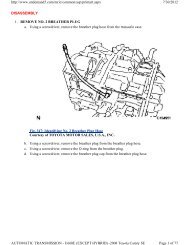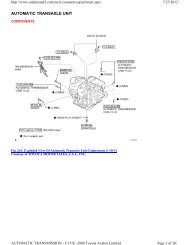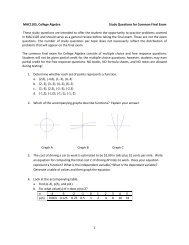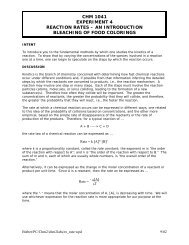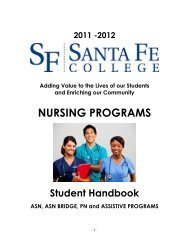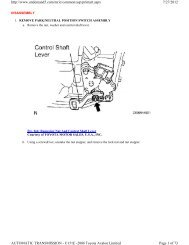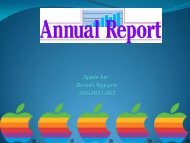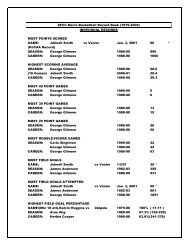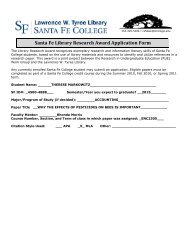Teaching Perspectives Inventory
Teaching Perspectives Inventory
Teaching Perspectives Inventory
Create successful ePaper yourself
Turn your PDF publications into a flip-book with our unique Google optimized e-Paper software.
TEACHING PERSPECTIVE<br />
INVENTORY<br />
WWW.TEACHINGPERSPECTIVES.COM<br />
JOHN COLLINS, PHD<br />
DAN PRATT, PHD
INTERPRETING YOUR TPI PROFILE<br />
Note the Range of Your Overall Scores<br />
Check the Differentiation among Your<br />
<strong>Perspectives</strong><br />
Check for Internal Consistency<br />
Examine any Internal Discrepancies<br />
Look for Consistency Across <strong>Perspectives</strong>
TRANSMISSION: KNOWLEDGE<br />
“Effective teaching requires a substantial<br />
commitment to the content or subject matter.”
TRANSMISSION<br />
Teachers - present content accurately and<br />
efficiently<br />
Students - learn content in its proper form<br />
Good teachers lead students systematically to<br />
content mastery<br />
Good teachers are enthusiastic about the content<br />
and convey that excitement to the students<br />
Good transmission teachers present material in a<br />
memorable way
TRANSMISSION – THE DOWNSIDE<br />
May find it difficult to work with people that do not<br />
understand the logic of your content.<br />
May have trouble anticipating where and why<br />
learners are likely to struggle with the content.<br />
May struggle to think of examples or problems<br />
from the „real world,‟ outside the classroom, as a<br />
means of making content come to life.<br />
May spend too much time talking.<br />
May be primarily focused on the content rather<br />
than the learners.
APPRENTICESHIP: SKILLS<br />
“Effective teaching is a process of socializing<br />
students into new behavioral norms and ways<br />
of working.”
APPRENTICESHIP<br />
Good teachers are highly skilled practitioners<br />
They show the methods for skilled<br />
performance, often using a set of tasks that<br />
progress from simple to complex<br />
As learners increase competence, the role of<br />
the teacher changes as less direction is offered<br />
and more responsibility is given to the student
APPRENTICESHIP – THE DOWNSIDE<br />
May have trouble finding relevant and authentic tasks<br />
for classroom instruction.<br />
It is difficult to match learners‟ capabilities with tasks<br />
that represent legitimate work.<br />
Difficult to find the right time to transition from<br />
“direction” to “responsibility”<br />
Many instructors find it difficult to put their „craft‟<br />
knowledge or skill into words. They will often say, “I<br />
know what to do; but it‟s difficult telling others how I do<br />
it.” The longer we have been doing complex tasks the<br />
more routine they become. The more routine they are,<br />
the less we need to articulate what we do. We just do it.
DEVELOPMENTAL: ABILITIES<br />
“Effective teaching must be planned and<br />
conducted “from the learner‟s point of view”.”
DEVELOPMENTAL<br />
Good teachers understand how students think and<br />
reason about the content<br />
Help learners increase complexity of cognitive<br />
structures<br />
This can be done with:<br />
Effective questioning that challenges higher level<br />
thinking<br />
Examples that are meaningful and relevant to the<br />
students.<br />
Good teachers adapt their knowledge to the level<br />
of the students
DEVELOPMENTAL – THE DOWNSIDE<br />
Hard to find good questions that require time to think<br />
and reason before answering.<br />
Finding the appropriate time to wait after asking the<br />
question, while learners think and voice their thoughts,<br />
takes practice and patience.<br />
It is difficult to refrain from telling learners, rather than<br />
letting them figure it out for themselves, especially when<br />
we know the answer.<br />
Difficult to develop practice and assessment tasks that<br />
are consistent with complex reasoning. They tend to<br />
focus on recall, recognition, and correct answers, rather<br />
than on reflection, analysis and reasoning.
NURTURING: ATTITUDES<br />
“Effective teaching assumes that long-term, hard,<br />
persistent effort to achieve comes from the<br />
heart, not the head.”
NURTURING<br />
Learners are better when they know that:<br />
They can succeed at learning if they try<br />
Their successes are results of their own efforts<br />
Their efforts are supported by teachers and peers<br />
Good teachers make no excuses for their students but<br />
they encourage the efforts<br />
Encouragement is provided with clear expectations of<br />
learners to achieve challenging yet attainable goals<br />
Learning assessments will consider the growth of<br />
individual students as well as absolute achievement, but<br />
caring does not negate high expectations
NURTURING – THE DOWNSIDE<br />
May be viewed by colleagues as having lower<br />
standards.<br />
It may be hard to draw the line between<br />
teaching and counselling<br />
The balance between caring and challenging<br />
is difficult to achieve and sustain, especially<br />
with a diverse group of learners.<br />
May want too much to be liked by students.
SOCIAL REFORM: VALUES<br />
“Effective teaching seeks to change society in<br />
substantive ways.”
SOCIAL REFORM<br />
See their role as instruments of social change<br />
Known among colleagues and students as<br />
advocates for societal change<br />
Good teachers challenge the status quo and<br />
promote the same among students<br />
Students are encouraged to take a stance that<br />
gives power and a platform to aid in social<br />
action.
SOCIAL REFORM – THE DOWNSIDE<br />
Students may not be ready to accept the<br />
values of the instructor<br />
Content may suffer in order to give<br />
preference to the “soap box”<br />
May find it difficult to continually tie subject<br />
matter to desired societal change
SELF-CORROBORATION<br />
Are the scores on your profile sheet consistent with<br />
how you see yourself?<br />
Do they make overall sense to you?<br />
Are there any unexpected insights?<br />
Do your scores help you clarify how you see yourself<br />
as a professional educator?<br />
How might it help you draft a written <strong>Teaching</strong><br />
Philosophy Statement?<br />
PEER/ PROFESSIONAL VALIDATION
RECONFIRM OR CHECK FOR CHANGE<br />
The TPI can be taken again to see changes and<br />
“improvements”<br />
Go to www.teachingperspectives.com if you<br />
wish to take the assessment again
TEACHING PERSPECTIVE INVENTORY<br />
WWW.TEACHINGPERSPECTIVES.COM<br />
JOHN COLLINS, PHD<br />
DAN PRATT, PHD






